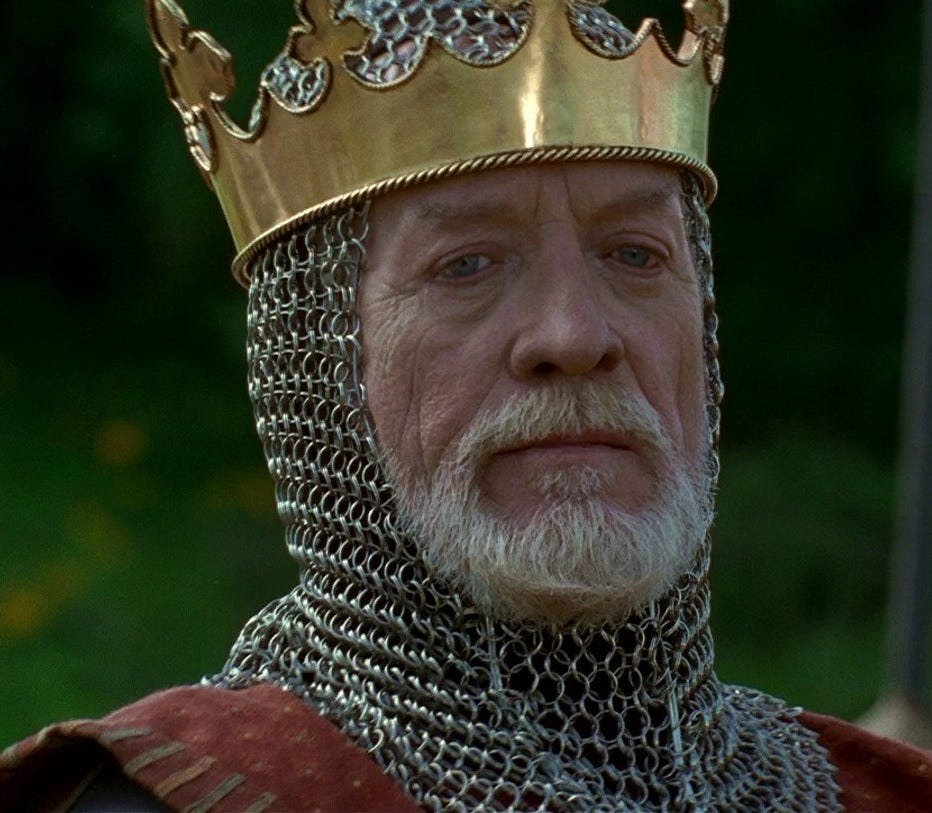But I have calmed and quieted my soul,
like a weaned child with its mother;
like a weaned child is my soul within me.
Psalm 131:2.
My resting heart rate is 110 beats-per-minute without medication. For many years I was subjected to every test under the sun, but all I ever got was a lot of shrugged shoulders and answers best summarized as “sucks to be you.” Medications get it down to an average of 85 bpm, and that seems to satisfy the White Coats.
Psychiatry offered the most plausible explanation, and since we’re all friends here I’ll give you my official diagnosis, which has been with me in various forms for 40 years: major depressive disorder with generalized anxiety disorder. After many years, it is very well controlled with medication (and, yes, prayer), but it still breaks through on occasion.
I can assure you–contra Fr. Chad Rippenger and any number of other know-nothings who spout unvarnished and destructive idiocy on the subject of mental health and Catholicism–it is not some kind of spiritual defect or failure of faith. I vividly recall symptoms (persistent anxiety nightmares) from about the time I was three. There are certainly psychological and spiritual vectors in mental health, and demons absolutely make use of our illness and weakness, but denying underlying biochemical elements or the benefits of medication is not just wrong: it’s spiritually corrosive.
I don’t know how or why I wound up with a skull full of mis-wired gray mush, but I generally blame the Irish. My family tree is full of people much like me. The tendency toward alcoholism in the Irish is an entire ethnicity self-medicating. Genes are funny ole things.
Prayer and meditation must be an integral part of anyone dealing with depression and anxiety. For this reason, Centering Prayer may appeal to some Catholics, since it uses similar techniques to those often recommended for people with depression and anxiety. I’m writing this post for people on either side of the equation: those who practice centering prayer, and those afraid to use even the most basic elements of meditation to help their anxiety. We need to find a middle path, so let’s look at what Centering Prayer is and isn’t, and then how it’s distinct from some techniques used for anxiety. (Feel free to skip to the next section if this is old hat.)
Baptizing TM
Centering Prayer was developed in the 1970s in response to the youth culture’s obsession with Eastern religions and their subsequent turning away from Christianity. Thomas Merton’s dabbling in Eastern spiritual techniques inspired priests and religious to attempt a baptism of various Buddhist, Hindu, and Zen practices, particularly aspects of Transcendental Meditation (TM). They ran a squeegee of Christian terminology over the surface and called their new discovery Centering Prayer, claiming it as a recovery of ancient monastic techniques.
Formal Centering Prayer was preceded by the work of Benedictine priest John Main, who simply took what he learned at the feet of Swami Satyananda and replaced Hindi mantra words with the vaguely Hindu-sounding “maranatha” (Aramaic for “Come, Lord”) with almost no other change. (Given that “Lord” is a common way to refer to Krishna, this was barely even an adaptation.) The meditator simply sat quietly for a half hour twice a day repeating the mantra over and over again and seeking stillness in God. Main’s followers continue his work with World Community for Christian Meditation (WCCM). If there’s some meaningful distinction between TM and Main’s techniques, its eludes me.
Centering Prayer found its inspiration–and name–from Thomas Merton, and claims to follow in a tradition that includes The Cloud of Unknowing and the work of John Cassian as forerunners. It evolved at the hands of Trappist monks from St. Joseph's Abbey in Massachusetts, led by Fr. William Meninger, Fr. M. Basil Pennington, and Abbot Thomas Keating. Keating remains the public face of Centering Prayer, writing books on the subject and continuing his work through the group Contemplative Outreach.
Contemplative Outreach distinguishes itself from WCCM by claiming differences in technique and deeper Christian roots. Keating writes that the difference is one of “methods; one is totally receptive, the other is totally concentrative.”
Here’s what Keating means by receptive:
1: Choose a sacred word as the symbol of your intention to consent to God’s presence and action within.
2: Sitting comfortably and with eyes closed, settle briefly and silently introduce the sacred word as the symbol of your consent to God’s presence and action within.
3: When engaged with your thoughts, return ever-so-gently to the sacred word.
4: At the end of the prayer period, remain in silence with eyes closed for a couple of minutes.
On the surface, this seems inoffensive and perhaps even productive, but both the Vatican (in a pair of documents) and numerous commentators have had some problems with certain aspects, for good reasons.
I don’t want to belabor the objections to Centering Prayer, which have been outlined in some depth elsewhere, but here’s the condensed version:
It’s an attempted shortcut to an advanced state of silent contemplation. Contemplation for Dummies, if you will. The four waters and seven mansions of the great spiritual master St. Teresa of Avila are collapsed into a kind of quick-fix just-add-water reconstituted contemplation. There’s only one mansion, and it’s a pre-fab. Proponents will be quick to point out that the method of meditation is not the endpoint, but it’s certainly being pitched as something akin to a trip to the mall to get your picture taken with Jesus.
The entire movement is shot through with barely disguised pantheism–called by its own practitioners panentheism–that falls gravely short of a true sacramental world view or understanding of the Creator’s place in it. Certainly every baptized Christian is a temple of the Holy Spirit, but what we mean by the indwelling of the Spirit and what Eastern religions mean (for instance, by the oft-appropriated, rarely understood greeting “namaste”) is quite notably different. What’s lacking is the sense of God’s ultimate transcendence.
Centering prayer is very shallow. The idea is to empty the mind and heart so they can be filled with Jesus, but that’s really not how Christians see their relationship to God. It has a gnostic, anti-material sensibility. Christians can’t ascend to God through technique or will, but only through grace. Some are called to this deep union–this mystical experience–and some are not. Trying to grasp the experience through certain methods is akin to Pelagianism.
Much of the richness of Catholic mysticism and practice is deputized to add an air of legitimacy to centering prayer: The Cloud of Unknowing, Teresa of Avila, John Cassian, lectio divina, hesychasm, the Desert Fathers, and so on. The Catholic mystical tradition is deeper, richer, and, in particular, more challenging than CP suggests. CP has a gimcrack, dime-store quality to it. (Side note: I pray the Jesus Prayer–an aspect of hesychasm–and here’s an orthodox perspective on what makes it different.)
In short, repeating mantras in an attempt to hypnotize oneself into an ecstatic experience is not a viable Christian prayer technique.
But here’s where we come to the big red...
However…
One of the basic tools in the anxious person’s toolbox is simple meditation. This is not mystical practice or a path to divine union or anything else. Rather, it offers the opportunity for a person in the midst of an anxiety episode or panic attack to calm the mind and heart.
It entails very simple practices. Closed eyes. Counted breaths. Measured breathing. Even a repeated phrase. Heck, you can even say maranatha if that helps.
On the surface, this seems to be what Centering Prayer is offering, and what I am criticizing.
It is not, because I’m not using it as my way to achieve union with God. I am not attempting, in the words of Abbot Keating, to use the technique to move “through our inmost being into the divine presence itself which is the source out of which we emerge at every microcosmic moment of time.” I’m just trying to get my heart rate down before I keel over.
I’ve encountered some people who are overly scrupulous and think even this technique is verboten, but if we are not performing it in order to force a mystical moment of encounter with God there is no problem. We are not, in the “kids, please don’t drink the bong water” language of M. Basil Pennington, attempting to “leave behind time and place and separateness,” so we “come to our Source and are in the Being from which we ever flow and in which we ever stand and apart from which we are not."
That’s not what counted breaths, basic repetition of words or phrases, and other anxiety-reducing techniques are. Repetition in prayer is good: it focuses the mind and creates a rhythm in prayer, etching the word of God in the mind and heart. Both the Rosary and the Jesus Prayer use structure and repetition. They are not, however, an attempt to empty the self found in Centering Prayer, but a way of finding simple stillness, of calming the roaring mind, of slowing the racing heart, of finding a light place in the darkness, a quiet place in the noise, a peace of mind and body.
We may certainly call out to God in these moments, and reach out to Him for help. We may even transition in and out of prayer at this moments. But God is always Other. We are not creating a prayer discipline based upon techniques, nor are we trying to storm the highest reaches of contemplation through a simple parlor trick.
This is a fine distinction, and I hope I’ve made it clear for both the misguided who seek New Age techniques of meditation and for the suffering who may shun a basic and useful tool. I passed through a great deal of Eastern Mysticism on my way back into Catholicism, and I understand the fascination. I even value many of the insights I learned during my time in the wilderness. But Eastern-style meditation is based upon a fundamentally different understanding the human person, the universe, the material world, prayer, the soul, and God. It is not adaptive, and it cannot be baptized.
There are many ways through depression and anxiety in prayer and meditation, and I plan to write about the subject more. Centering Prayer, however, is not one of them.




